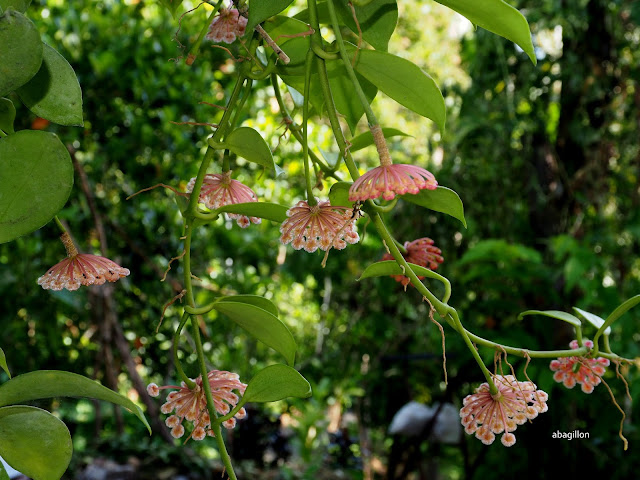Hoya obscura is one of the about 200 species of hoyas endemic or native to the Philippines. The first documented collections were from Bulusan, Sorsogon, but later found in many areas in the country. Being endemic to the country however, does not mean it is still fully available in the wild. It is now mostly found in private nurseries locally and in specialized gardens and collectors in other countries. It was just noticed and sought after here by hobbyists in the last few years, which could also have aggravated its demise in the natural habitat.
The plant is medium size, more compact than other hoyas and grows favorably downwards in hanging baskets. Leaves are mostly green to light green with conspicuous veins. It belongs to the hoyas with milky sap. The flowers are drooping downwards with flat umbel, and the corolla is hairy revolute. The leaves sometimes turn pinkish when exposed to colder weather in a sunny environment.
It is friendly to a hoya beginner, as it is easy to grow, and responds favorably to normal caring. But just like most of the hoyas it doesn't need wet roots all the time. Drying between watering is a requirement, in a media that is well drained.
The flowers in the above photo can make the vicinity radius of 5 meters to be sweetly smelling of citrusy cinnamon buttered bread. My hoya garden is just 1 meter away from the terrace, and drinking coffee and toast in the morning feels more luxurious when the flowers are in bloom. I haven't heard someone not liking the scent of Hoya obscura.
The flowers are normally visited by ants, which partake their share of nectar or whatever satisfies them there. Other insects are also seen lingering in this hoya plant. Those peduncles bearing the flowers must not be cut, as the flowers always emerged at the tips. Flowering is continuous when the plant is growing very well.
The 3 umbels above represents 3 stages of maturity, with the buds clearly seen. The other 2 umbels not in focus are fully blooming with the yellowish one being the older.
Unopen buds show dark pink around each flower, together with the pedicels. Even at the unopen stage the flowers are already beautiful.
Above photo shows the typical size and color of the fully opened flowers. The corolla are still pinkish with the corona always yellow. Color hues of the corolla are also governed by many factors of the environment including sunlight, temperature, pH of the media.
Above is a representative of the already advanced bloom. They become more yellow or lighter yellow as they approach dehiscence.
They turn full yellow in 3 days when the flowers are ready to drop.
a black ant lingers on the flowers









So lovely, views that I have never seen.
ReplyDeleteBeautiful flowers, but they wouldn't last a day in my climate!
ReplyDeleteMost successful hoya collectors are even in Northern Sweden, Vermont, New York, and many parts of the US
DeleteYour macros are the best! Especially with Hoyas. That last one with the ant is stunningly beautiful.
ReplyDeleteThanks so much Beth, you are so kind.
Deletethey are amazing flowers! just incredible!
ReplyDeleteMarvelous photos of a very beautiful an interesting flower.
ReplyDeleteOh how beautiful!
ReplyDeleteSo pretty and delicate. Love the colour.
ReplyDeleteReally interesting images!
ReplyDeleteBeautiful pictures of a flower I didn't know ! Thank you for sharing !
ReplyDeleteWhat a fabulous thing
ReplyDeletemollyxxx
Amazing!!!
ReplyDeleteAmazing and lovely shots.
ReplyDeleteGreat photos of the Hoya obscura. So very interesting you can grow these Hoyas outside, I see they are native to the Philippines. Sometimes we can buy them here as houseplants and I love them.
ReplyDeleteI will be your new follower.
Regards, Janneke
Thank you Janneke, here when we say inside the greenhouse, it is just but a net-covered enclosure where wind, temperature and humidity are still the same as outside. It is much different than in temperate countries where greenhouses have controlled conditions. I see in the internet of a very big greenhouse there in the Netherlands growing a lot of hoya seedlings. I just forgot the name but it is real big.
DeleteHello, what a lovely plant and beautiful blooms. Lovely images and macro shots. Happy Tuesday, enjoy your day!
ReplyDeleteThank you for all your nice comments on my blog Andrea..especially about the baby. He makes me smile everyday and we need that in today's world.. I am always amazed at mother nature and all the beautiful flowers...Michelle
ReplyDeleteThis is beautiful. No wonder you are enamored by it. Happy Holidays.
ReplyDeleteWorth a Thousand Words
What a wonderful variety, Andrea! I'd never seen this species before.
ReplyDeleteMany thanks for joining us on the Floral Friday Fotos meme.
Nature is so awesome and full of loveliness! These shots are really great.
ReplyDeleteWhat an incredibly looking flower. It looks beautiful but at the same time out of this world. Ah! I wish I could grow it here.
ReplyDelete